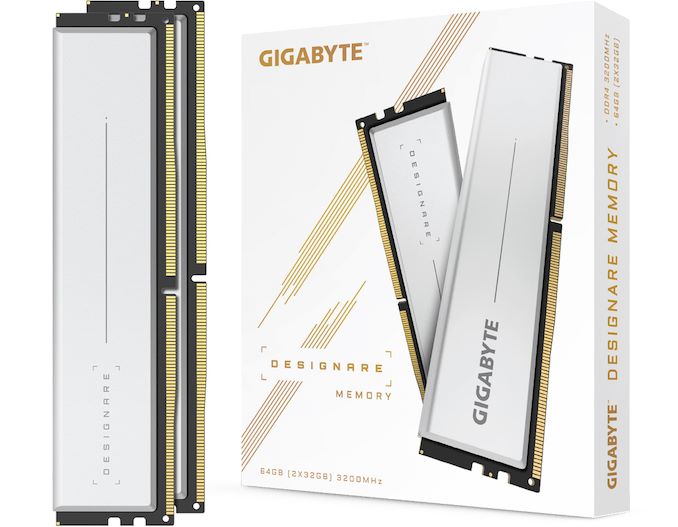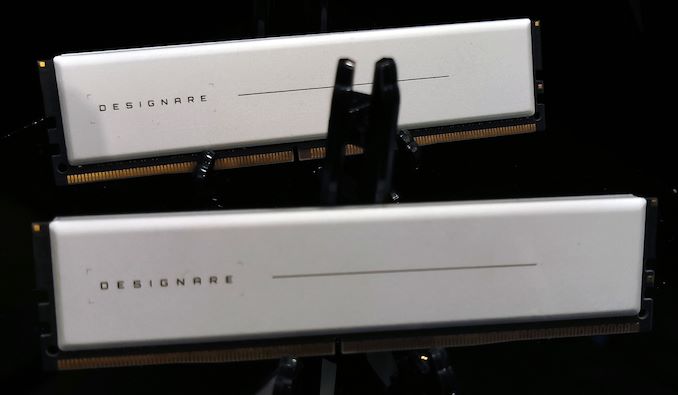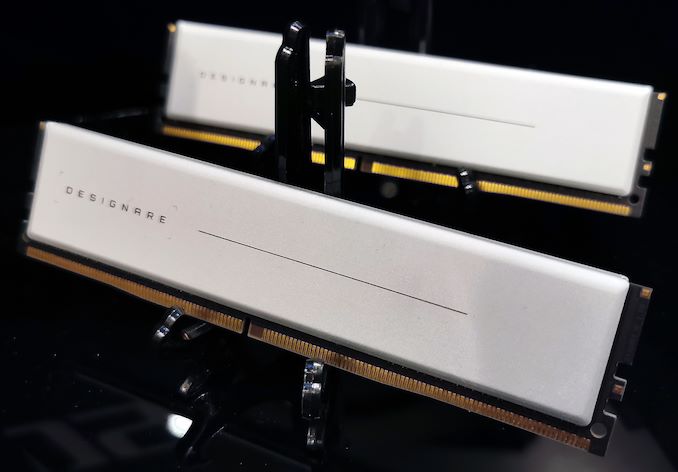GIGABYTE Launches Designare DDR4-3200 Memory, a 64 GB Kit
by Anton Shilov on February 6, 2020 10:00 AM EST
GIGABYTE is a relatively new player on the memory market, yet it clearly wants to participate in the premier league. As seen at CES, this week the company introduced its Designare 32 GB memory that claims to offer both high speed and low latency. The company positions its Designare memory for high-performance systems powered by Designare motherboards.
GIGABYTE’s dual-channel 64 GB Designare Memory kit was tested to operate in DDR4-3200 mode with CL16 18-18-38 latency at 1.35 V. The modules rated for Intel Core as well as AMD Ryzen-based PCs.
The manufacturer does not disclose which memory chips it uses.
The modules are a standard height and come with modest aluminum heat spreaders that do not affect compatibility with large cooling systems.
GIGABYTE’s Designare 64 GB kit consisting of two 32 GB modules is covered by a lifetime warranty, just like other high-end memory. Expect the kit to hit the market shortly - prices will vary from region to region and will depend on the market conditions.
Related Reading
- Crucial’s 32 GB UDIMMs and SODIMMs Available: DDR4-2666 & DDR4-3200
- 32 GB Unbuffered DIMMs Listed from Nine Brands: DDR4-2400 to DDR4-4000
- Crucial 32 GB DDR4 Modules Found in an ASRock System
- CES 2020: Kingston’s HyperX Adds 32 GB UDIMMs & New Fury Speed Bins to Lineup
- Team Group Quietly Launches 32 GB DDR4 Memory Modules
- G.Skill Launches 32 GB DDR4 Modules, 256 GB Kits: Up to DDR4-4000
- Corsair Unveils 32 GB Vengeance LPX DDR4 DIMMs, 64 GB & 128 GB Dual-Channel Kits
- Samsung 32GB DDR4-2666 Non-ECC Memory at Retail: $168
Source: GIGABYTE













22 Comments
View All Comments
jabber - Thursday, February 6, 2020 - link
mmmm RAM for the over 30's! I like. Continue with this trend across all hardware please.QQBoss - Friday, February 7, 2020 - link
While I would get totally geeked if they could get this up to 3600 while keeping it at CL16, I am far more concerned about having that much memory in use at those tiny design rules and no ECC for dealing with SEU (Single Event Upset)? It seems to be more of a problem for SRAM, but DRAM must surely be dense enough to be causing a problem? It is a problem for CMOS image sensors that are used in satellites, for sure.From a 2009 IEEE paper: "Current technologies are sensitive to low Linear Energy Transfer particles such as alphas. These particles can be spontaneously produced by some radioactive elements, called alpha-emitters. Here, we investigate two examples of emitters, Hafnium and Uranium. By calculating the disintegration rate in a modern technology with hafnium dioxide, we show that hafnium has no incidence on Soft Error Rate. Moreover, from Monte Carlo simulations, we point out that natural Uranium concentration in a silicon wafer lead to a Soft Error Rate comparable to that due to neutrons at ground level."
Not to mention cosmic rays for people who live at the altitude of Colorado Springs (for example), which I remember reading about in older literature.